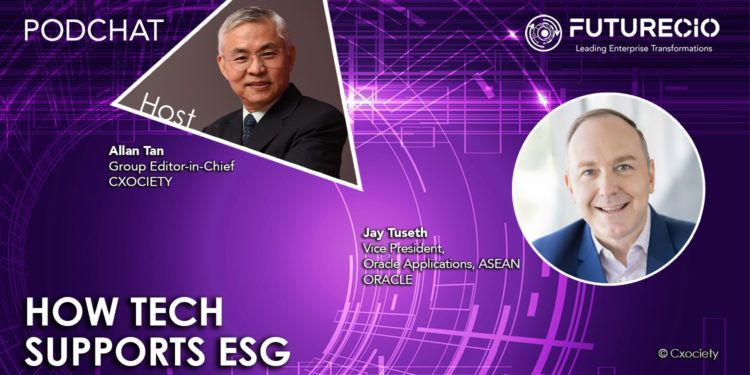Environmental, social, and corporate governance is an approach to evaluating the extent to which a corporation works on behalf of social goals that go beyond the role of a corporation to maximize profits on behalf of the corporation's shareholders.
In recent years, climate change has elevated the visibility of ESG initiatives. While the Board has traditionally had oversight over ESG, increasingly we are seeing the CFO take on the role of manager reporting to the Board.
But what about the CIO? IT systems which support many business processes themselves consume energy and generate waste, thereby contributing to carbon emissions. What can the CIO do to drive the organisation’s ESG initiative?
Jay Tuseth, vice president of Oracle Applications in ASEAN, cites regulatory changes as one of the biggest limiting factors towards the wider adoption of sustainability initiatives in Asia. He also concedes that the systems and processes people are using today have not kept up with the changing dynamic of people, whether that's employees or customers.
Finally, the other limiting factor is the difficulty in measuring sustainability. “Looking at the way that organisations can gather data, collect data and analyse it, it's really difficult to have an understanding of how sustainability works for an organisation,” he added.
That said, he also acknowledged that much of the progress around sustainability will be driven by people’s attitudes.
“People today, whether they're customers or they’re employees, are fed up with the lack of progress around sustainability as a global society. They think businesses can do more and want to make choices and decisions based on this desire to see more sustainability in the world. If people don't incorporate sustainability into their business, they're going to be leaving customers behind,” he elaborated.
Technology to support ESG
Tuseth believed that the use of Artificial Intelligence, machine learning, and bots, has the potential to eliminate bias and create better decision-making around sustainability. He also pointed to the ability to capture data, analyse, and interpret it in meaningful ways as a second important driver.

“The third is shifting business processes internally, to automate and transform the organisation to become an enabler of new capabilities, eliminating a lot of the externalities that people see today, relative to these sustainable ways,” he added.
Tuseth acknowledged that there is a glut of data that organisations must manage. When allowing machines to enhance the decision-making of people, data has been the missing component. He posits that this data needs to be accessible and readily utilised.
“The simplest way to take data and make it more accessible is through new capabilities like cloud technologies, where you can have a common data construct for information in a commonplace and use that across multiple applications and multiple business processes seamlessly. The ability to look at cloud technologies, which gives the ability to have all your data centrally located in a common area, gives you the ability to do that,” he suggested.
Advice for leadership
Tuseth believed that CIOs and the C-suite need to understand the negative impact of not providing sustainability within the organisation. Consumers today are making choices based on the sustainability initiatives that organisations are providing. It is mission-critical and needs to be addressed accordingly.
“CIOs need to look at their own organisation and really understand what are the processes that they can support and automate, what are the capabilities they have to improve sustainability relative to power use, and which things are really specific to IT that they have direct control over,” he commented.
“The next phase from that is looking more holistically at the organisation and saying, what are some areas from that we can enable from a technology perspective, to support broader sustainability goals,” concluded Tuseth.
Click on the PodChat player and listen to Tuseth talk about strategies for enhancing how tech supports ESG.
- What are the three major factors or megatrends driving the increased focus on sustainability across key markets in Asia Pacific?
- What do you think will be the key driver behind enterprise sustainability efforts in the near to medium term?
- Do you anticipate the pandemic to have a significant impact on these efforts?
- What are the top three technologies in use today that can enhance the effectiveness or success of ESG initiatives?
- With sustainability and digital transformation at the top of the business agenda in 2022, what can organisations across Asia Pacific do to maximise the potential of data at their disposal?
- How should the CIO work with the sustainability officer or in some cases the CFO around the use and protection of data in pursuit of sustainability and social goals?
- What is your advice to CIOs as to how they can support an organisation’s sustainability and social goals?





